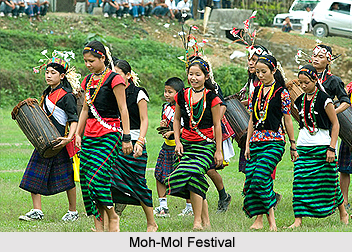 Festivals of Changlang district of Arunachal Pradesh primarily belong to the tribal communities. For instance, Moh-Mol is basically an agricultural festival that is celebrated by the Tangsa Tribe. It signifies the end of an agricultural activity or beginning of crop season. Since life and activity of tribal people revolve around agriculture, this festival is of utmost importance. Celebrating Moh-Mol involves the show of vibrant traditional costumes, ornaments, art and crafts that enriched the pride of Tangsa`s cultural heritage. It, therefore, inspires younger generation every year to inherit, protect, preserve and pass it on to the later generations.
Festivals of Changlang district of Arunachal Pradesh primarily belong to the tribal communities. For instance, Moh-Mol is basically an agricultural festival that is celebrated by the Tangsa Tribe. It signifies the end of an agricultural activity or beginning of crop season. Since life and activity of tribal people revolve around agriculture, this festival is of utmost importance. Celebrating Moh-Mol involves the show of vibrant traditional costumes, ornaments, art and crafts that enriched the pride of Tangsa`s cultural heritage. It, therefore, inspires younger generation every year to inherit, protect, preserve and pass it on to the later generations.
While some communities of Tangsa observe it at beginning of agricultural activity in the field, some do it while sowing of paddy, and some other for welcoming new crop into home. That is why celebration is performed with religious fervour and devotion. People chant mantras for good harvest of their crops, prosperity of their livestocks and wealth, and disease free live of their family or village community to enjoy food and drinks year after year. Therefore, the offerings, sacrifices, food, drinks, folk songs and dances escorted by rhythmic melody of drumbeats and gong reverberations highlight the festival.
Some communities of Tangsa, on Moh-Mol eve, bid farewell to departed soul of the family, in case, any members expired during that year. However, with the passage of time, certain changes have seeped into this festival.
Pongtu Kuh Festival, another festival of the Changlang district, is an ancient agricultural festival celebrated by Tutsa Tribe, on the eve of rainy season. The literary meaning of Pongtu is `retreating winds` and "khu" means festival. The festival is celebrated after the harvesting of millet to welcome the New Year. Pongtu is observed to offer prayer to the supreme god Rangkathok for a good yield, prosperity and seek security of the crops from natural calamities, pests, etc. this festival in the Changlang district is celebrated in the month of April every year with a lot of fervour. The festival is marked by several events like practicing of Rom-Hom, a traditional chicken sacrifice for producing fire through rubbing a bamboo stick in hay in order to forecast whether the year would prove prosperous for them or not. It is believed that the sacrifice is offered to the deity of the house and is practiced by only a section of the Tutsa tribe. Tutsa dance is performed by the youth.
The Singpho festival, Shapawng Yang Manou Poi is celebrated in the month of February every year. The Singpho youths in their traditional wardrobe display colourful dances with their usual tradition of drinking and eating. The prayers are offered to the Almighty for peace and prosperity of the people and area during the festival.



















